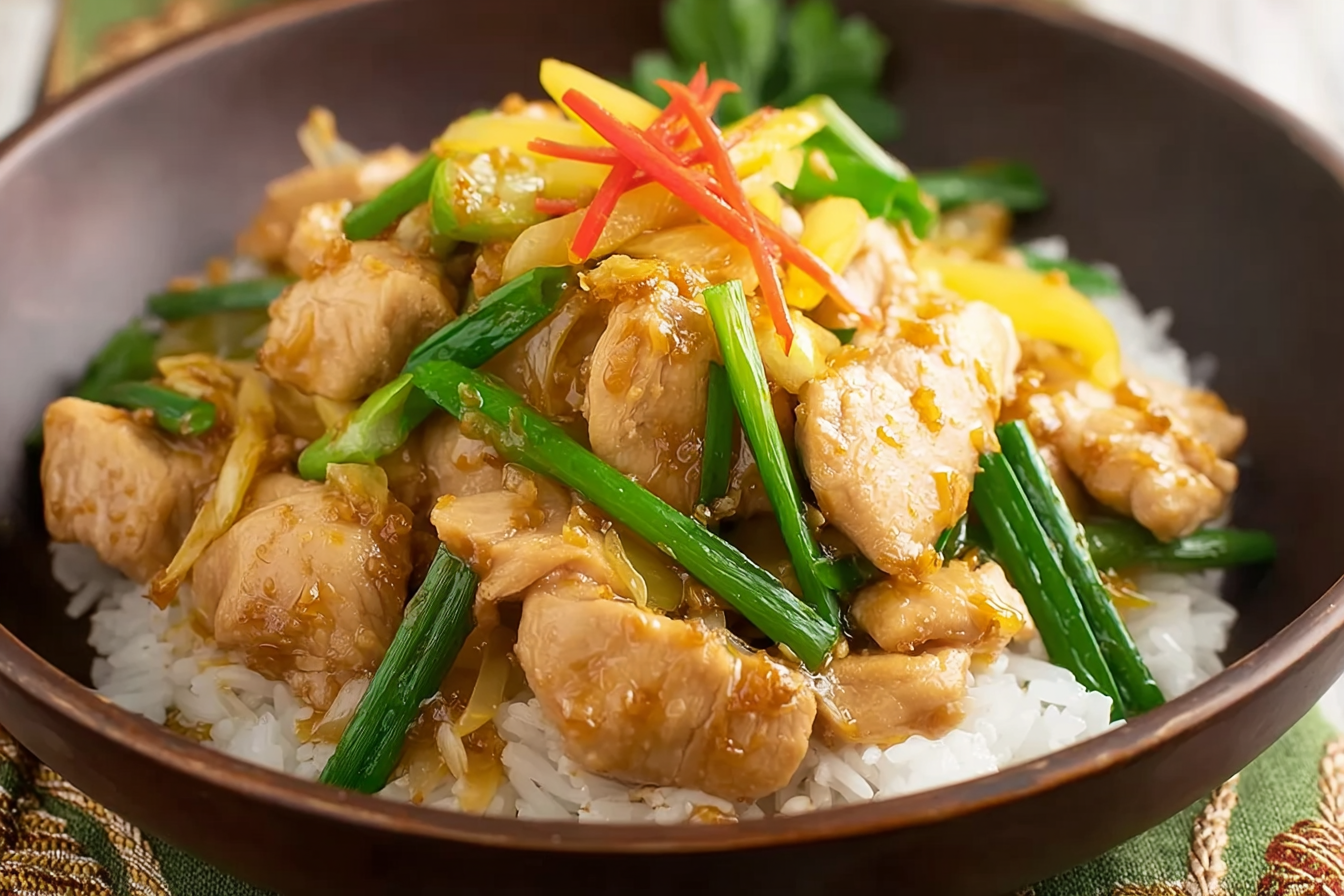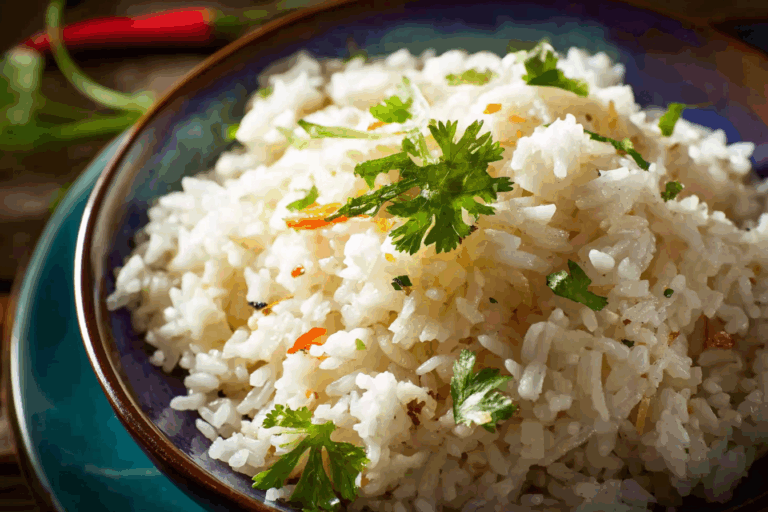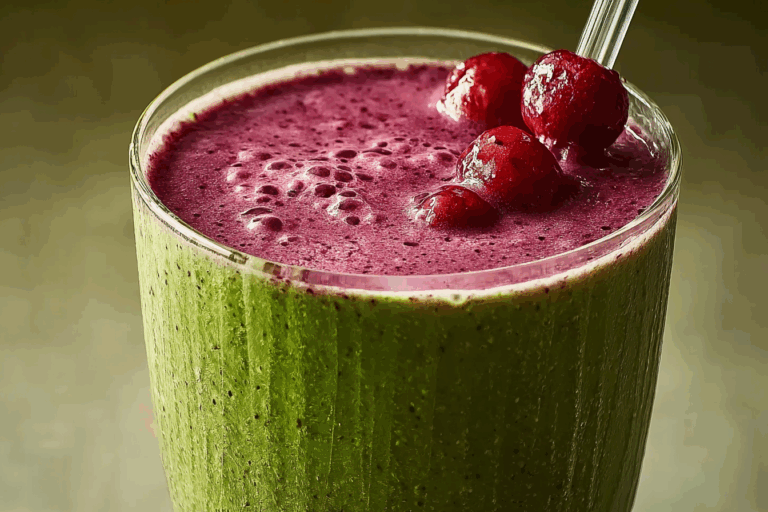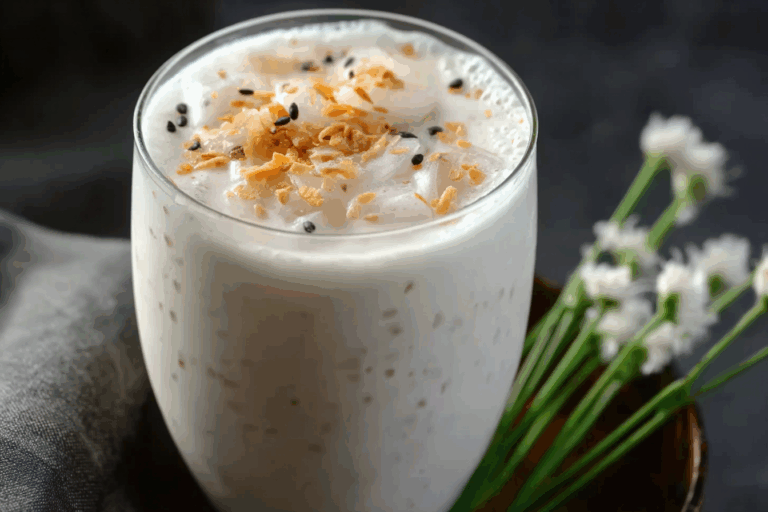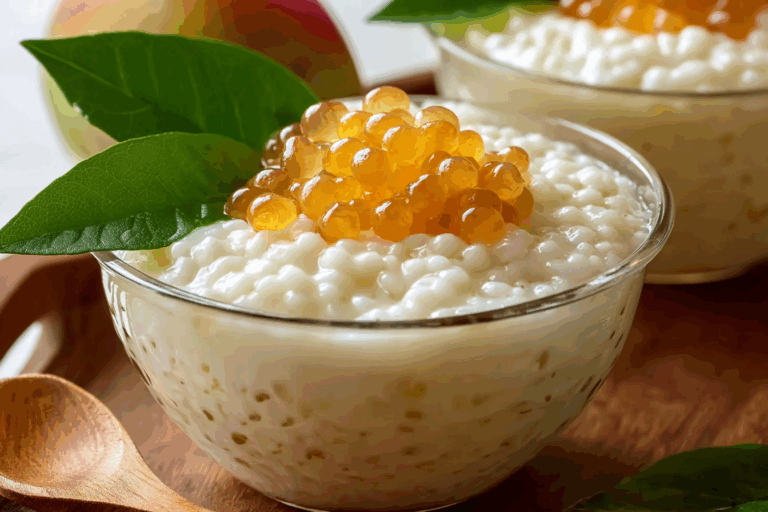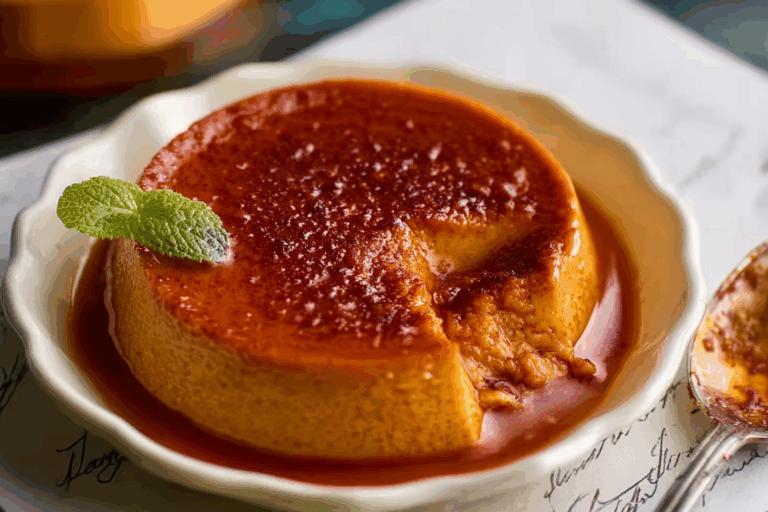Thai Ginger Chicken: A Flavor-Packed Stir-Fry You’ll Love
Thai Ginger Chicken is the kind of dish that makes you stop mid-bite, savoring the perfect balance of heat, sweetness, and the unmistakable zing of fresh ginger. It’s more than just a stir-fry; it’s a flavorful journey into the heart of Thai cuisine. At JustThaiRecipes, Lina and her partner started their culinary adventure to bring the authentic flavors of Thailand to homes around the world. They’ve poured their passion for fresh, bold ingredients into every recipe, ensuring that even beginner cooks can recreate the magic of Thai kitchens.
This guide is your ultimate companion to mastering Thai Ginger Chicken, also known locally as Gai Pad King. We’ll dive deep into its origins, explore the ingredients that make it shine, and share a step-by-step method so you can whip up this restaurant-quality dish at home. If you’re wondering how this simple stir-fry became a global favorite or how to get the perfect balance of flavors, you’re in the right place.
Whether you’re searching for an authentic Thai Ginger Chicken recipe or an easy Thai ginger chicken stir-fry recipe, keep reading to unlock every secret behind this dish’s irresistible charm.
Check out our Thai Chicken and Ginger Noodles for another flavorful twist you’ll love.
Table of Contents
Table of Contents
Understanding Thai Ginger Chicken
What Is Thai Ginger Chicken?
Thai Ginger Chicken, or Gai Pad King, is a traditional Thai stir-fry that pairs tender chicken with aromatic vegetables and the sharp, invigorating flavor of fresh ginger. The dish is often enhanced with a medley of ingredients such as red bell peppers, mushrooms, green onions, and cilantro. Finished with a savory-sweet sauce made from fish sauce, oyster sauce, sugar, and a touch of chili paste, it strikes the perfect balance between umami, heat, and sweetness. Served over a bed of steaming jasmine rice, it’s a satisfying, nutritious meal that’s easy enough for a weeknight dinner yet elegant enough for entertaining guests.
Unlike its spicier cousins, Thai Ginger Chicken emphasizes the warm, zesty notes of ginger rather than heavy heat. This makes it a popular choice for those new to Thai cuisine or anyone looking for a lighter, more aromatic dish.
Why Is It So Popular in Thai Cuisine?
Part of Thai Ginger Chicken’s appeal lies in its simplicity. It’s quick to prepare, packed with fresh vegetables, and incredibly adaptable. The use of fresh ginger not only adds a unique flavor but also delivers numerous health benefits, making it a staple in Thai home cooking.
In Thai street markets, you’ll often find vendors whipping up Gai Pad King in sizzling woks, the fragrance of ginger mingling with garlic and soy sauce wafting through the air. This accessibility and versatility have made Thai Ginger Chicken a household favorite not only in Thailand but also among Thai food enthusiasts worldwide.
The dish also serves as a gateway to more adventurous Thai flavors. Its mild yet complex profile makes it perfect for pairing with spicier dishes like Red Thai Crispy Chicken Curry or milder options like Thai Iced Cocoa Milk.
If you’ve been searching for Thai Ginger Chicken recipe easy or a truly authentic Thai Ginger Chicken, rest assured this guide covers it all—from selecting the freshest ingredients to mastering the stir-fry technique for restaurant-quality results.
The History and Origins of Thai Chicken
Roots in Thai Culinary Traditions
Thai Ginger Chicken, known locally as Gai Pad King, is deeply rooted in the rich tapestry of Thai culinary history. This stir-fry isn’t just a random combination of ingredients; it represents centuries of Thai cooking wisdom, where balance, freshness, and speed in preparation are key. Traditionally, Thai cooking emphasizes creating harmony between flavors—spicy, sour, salty, sweet, and bitter. Gai Pad King fits beautifully into this philosophy with its zingy ginger, savory sauces, and sweet undertones from sugar and fresh vegetables.
Unlike curry-based dishes that require simmering for hours, Gai Pad King emerged from the need for quick, nourishing meals prepared in busy Thai households and street markets. Using a wok over high heat, cooks could transform simple, local ingredients into flavorful meals within minutes—a method that has stood the test of time.
Learn more about Gai Pad King’s authentic roots and cooking tips from Hot Thai Kitchen, where Chef Pailin shares her expertise on this beloved dish.
The Influence of Chinese Stir-Fry Techniques
The stir-fry technique used in Thai Ginger Chicken reflects the historical influence of Chinese immigrants in Thailand. In the early 20th century, Chinese communities brought the art of wok cooking, soy-based sauces, and stir-fried noodles to Thai cuisine. Over time, Thai cooks infused these techniques with their own ingredients, like fish sauce, fresh herbs, and spices, resulting in a hybrid of bold flavors and fast cooking methods.
This fusion is especially evident in Gai Pad King’s cooking process. The dish relies on intense heat to sear thin strips of chicken and vegetables quickly, preserving their natural textures and vibrant colors. It’s a perfect example of how Thai cuisine evolved through cultural exchange while staying true to its flavor-forward identity.
Discover how Thai Ginger Chicken reflects this cultural fusion on Simply Suwanee, where the story of this dish’s popularity unfolds beautifully.
In the next section, we’ll dive into the heart of every great Thai dish: the ingredients. Knowing what to use—and why—makes all the difference between an average stir-fry and a restaurant-quality Thai Ginger Chicken.
Print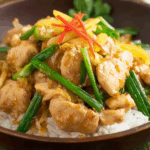
Thai Ginger Chicken
- Prep Time: 15 minutes
- Cook Time: 30 minutes
- Total Time: 45 minutes
- Yield: 4 servings 1x
- Category: Main Course
- Method: Stir-Fry
- Cuisine: Thai
- Diet: Low Lactose
Description
This Thai Ginger Chicken stir-fry is a quick and flavorful dish featuring tender chicken strips, fresh vegetables, and a punch of ginger, all coated in a savory sauce. Perfect for a weeknight dinner served over fluffy jasmine rice.
Ingredients
- 3 ½ cups water
- 1 ½ cups uncooked jasmine rice
- 2 tablespoons vegetable oil
- 1 pound skinless, boneless chicken breasts, cut into thin strips
- 3 cloves garlic, minced
- 4 green onions, cut into 2-inch pieces
- 1 large red bell pepper, cut into strips
- ¾ cup sliced fresh mushrooms
- ½ cup fresh ginger, cut into matchsticks
- 1 tablespoon Asian fish sauce
- 1 tablespoon oyster sauce
- 1 tablespoon white sugar
- ½ teaspoon Thai red chili paste, or to taste
- 2 tablespoons chicken broth
- Salt and ground black pepper to taste
- 2 tablespoons fresh cilantro leaves, for garnish
Instructions
- Bring water and jasmine rice to a boil in a saucepan. Reduce heat to medium-low, cover, and simmer until rice is tender and water is absorbed, about 20 to 25 minutes.
- Heat a wok or large skillet over medium-high heat. Add vegetable oil, then sauté chicken and garlic for 2 minutes.
- Add green onions, bell pepper, mushrooms, ginger, fish sauce, oyster sauce, and sugar. Stir-fry until chicken is no longer pink and vegetables are almost tender, about 3 minutes.
- In a small bowl, whisk Thai red chili paste into chicken broth until dissolved. Pour this mixture into the wok.
- Season with salt and black pepper to taste. Stir well and cook for an additional 1-2 minutes to heat through.
- Garnish with fresh cilantro leaves and serve hot over the prepared jasmine rice.
Notes
- For extra heat, increase the amount of Thai red chili paste.
- Use boneless chicken thighs for a juicier alternative.
- Vegetarians can substitute chicken with tofu and use soy sauce instead of fish sauce.
Nutrition
- Serving Size: 1 plate (with rice)
- Calories: 380
- Sugar: 6g
- Sodium: 820mg
- Fat: 10g
- Saturated Fat: 1.5g
- Unsaturated Fat: 7.5g
- Trans Fat: 0g
- Carbohydrates: 45g
- Fiber: 2g
- Protein: 26g
- Cholesterol: 55mg
Keywords: Thai Ginger Chicken, stir fry, chicken stir fry, Thai recipes, ginger chicken recipe
Essential Ingredients for Authentic Thai Ginger Chicken
The Core Ingredients Explained

Great Thai Ginger Chicken starts with the right ingredients. While it may look like a simple stir-fry, each component plays a crucial role in building the layers of flavor that make this dish irresistible.
Chicken
Boneless, skinless chicken breasts are the most common choice for Thai Ginger Chicken because they cook quickly and remain tender when sliced thinly. Some cooks prefer chicken thighs for their slightly richer flavor and juicier texture.
Fresh Ginger
Ginger is the star of this dish, and it’s essential to use fresh ginger rather than powdered or paste versions. Fresh ginger cut into matchsticks releases its oils and imparts a bold, zesty kick that powdered ginger simply can’t replicate.
Vegetables
Colorful, crisp vegetables not only make the dish visually appealing but also add texture and nutrition. Red bell peppers, mushrooms, and green onions are classic additions. The bell pepper brings sweetness, mushrooms contribute umami depth, and green onions add a mild sharpness.
Jasmine Rice
Steamed jasmine rice is the perfect aromatic companion to the stir-fry, absorbing the savory sauce and balancing the bold flavors.
Fish Sauce and Oyster Sauce
These umami-packed condiments are foundational in Thai cooking. Fish sauce provides a salty, savory depth, while oyster sauce adds sweetness and richness to the stir-fry sauce.
Sugar and Thai Red Chili Paste
A touch of sugar helps round out the flavors, while Thai red chili paste offers optional heat for those who prefer a spicier version.
Chicken Broth and Cilantro
A splash of chicken broth keeps the dish moist, and fresh cilantro leaves added at the end bring a burst of herbaceous freshness.
Why Freshness Matters
In Thai cooking, freshness is everything. Fresh herbs and vegetables ensure the dish maintains its vibrant colors and flavors, while fresh chicken guarantees tenderness. Even the sauces benefit from being opened recently, as aged fish sauce or oyster sauce can develop off-flavors over time.
Selecting the best quality ingredients doesn’t just elevate the flavor; it transforms Thai Ginger Chicken from a quick meal into a memorable culinary experience.
Step-by-Step Guide to Cooking Thai Ginger Chicken
Preparation of Ingredients
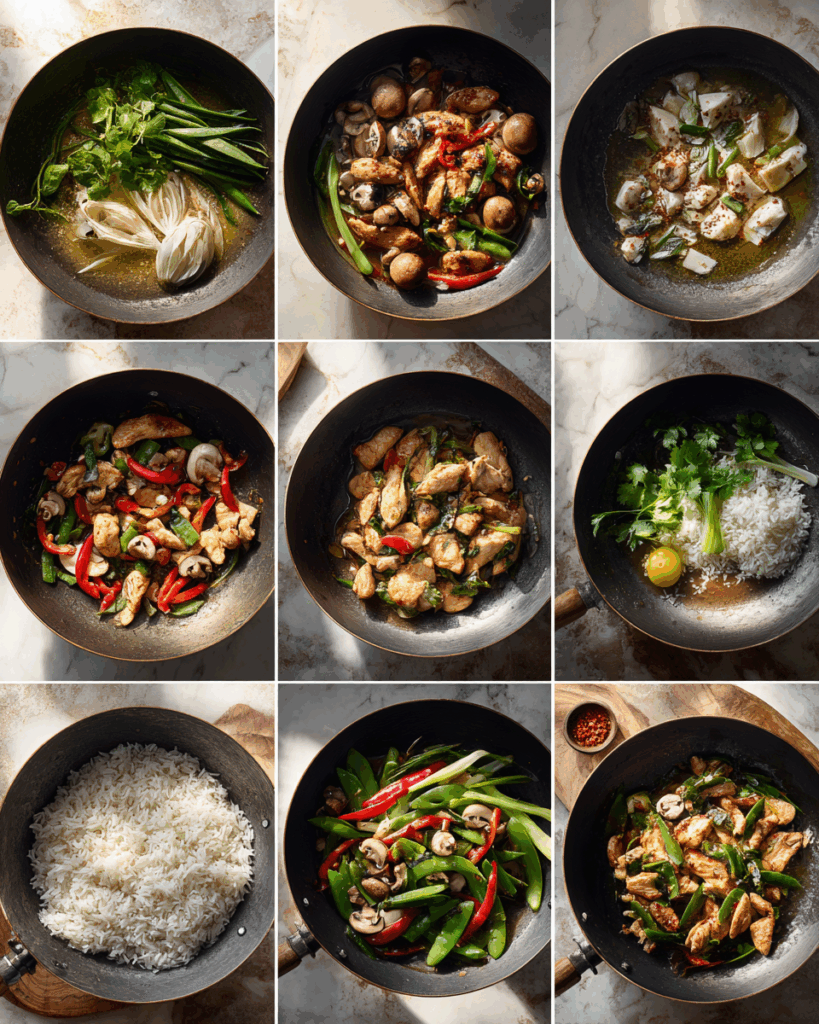
Before you turn on the stove, prepare all your ingredients. Thai cooking happens fast, so having everything ready ensures a smooth cooking process.
- Slice the chicken thinly against the grain for tender bites that cook evenly.
- Chop vegetables like red bell peppers, mushrooms, and green onions into uniform pieces to ensure they cook at the same rate.
- Cut fresh ginger into thin matchsticks. This releases its aromatic oils and allows it to mingle perfectly with the other flavors.
- Mince garlic finely for a fragrant base.
Cooking Process
Step 1: Cook the Rice
Begin by cooking jasmine rice. Bring 3 ½ cups of water and 1 ½ cups of uncooked jasmine rice to a boil in a saucepan. Reduce heat to medium-low, cover, and let it simmer until the rice is tender and all water has been absorbed. This usually takes about 20 to 25 minutes. Fluff with a fork and set aside.
Step 2: Heat the Wok
Place a wok or large skillet over medium-high heat. Add 2 tablespoons of vegetable oil and allow it to heat until shimmering.
Step 3: Stir-Fry Chicken and Garlic
Add the thinly sliced chicken and minced garlic to the hot oil. Stir-fry for about 2 minutes, ensuring the chicken gets a slight sear but doesn’t overcook.
Step 4: Add Vegetables and Ginger
Toss in the green onions, red bell peppers, mushrooms, and fresh ginger matchsticks. Stir-fry for another 3 minutes until the vegetables are tender-crisp and the ginger releases its aroma.
Step 5: Build the Sauce
Mix 1 tablespoon fish sauce, 1 tablespoon oyster sauce, 1 tablespoon sugar, and ½ teaspoon Thai red chili paste (adjust to taste) into 2 tablespoons of chicken broth. Whisk until the chili paste dissolves completely. Pour this sauce mixture into the wok and toss everything together to coat evenly.
Step 6: Season and Finish
Season with salt and black pepper to taste. Continue to stir-fry for another minute, ensuring the chicken is fully cooked and the sauce slightly thickens.
Step 7: Garnish and Serve
Remove from heat and garnish with 2 tablespoons of fresh cilantro leaves. Serve hot over a generous portion of jasmine rice for the ultimate comfort meal.
Common Mistakes to Avoid
- Overcrowding the Wok: Cook in batches if needed to prevent steaming the ingredients instead of stir-frying them.
- Overcooking Chicken: Thin slices cook quickly, so keep an eye on them to avoid dryness.
- Using Powdered Ginger: Fresh ginger is irreplaceable for its sharp, bright flavor.
Next, we’ll explore the health benefits of Thai Ginger Chicken and why this delicious dish isn’t just good for your taste buds but also for your body.
Health Benefits of Thai Ginger Chicken
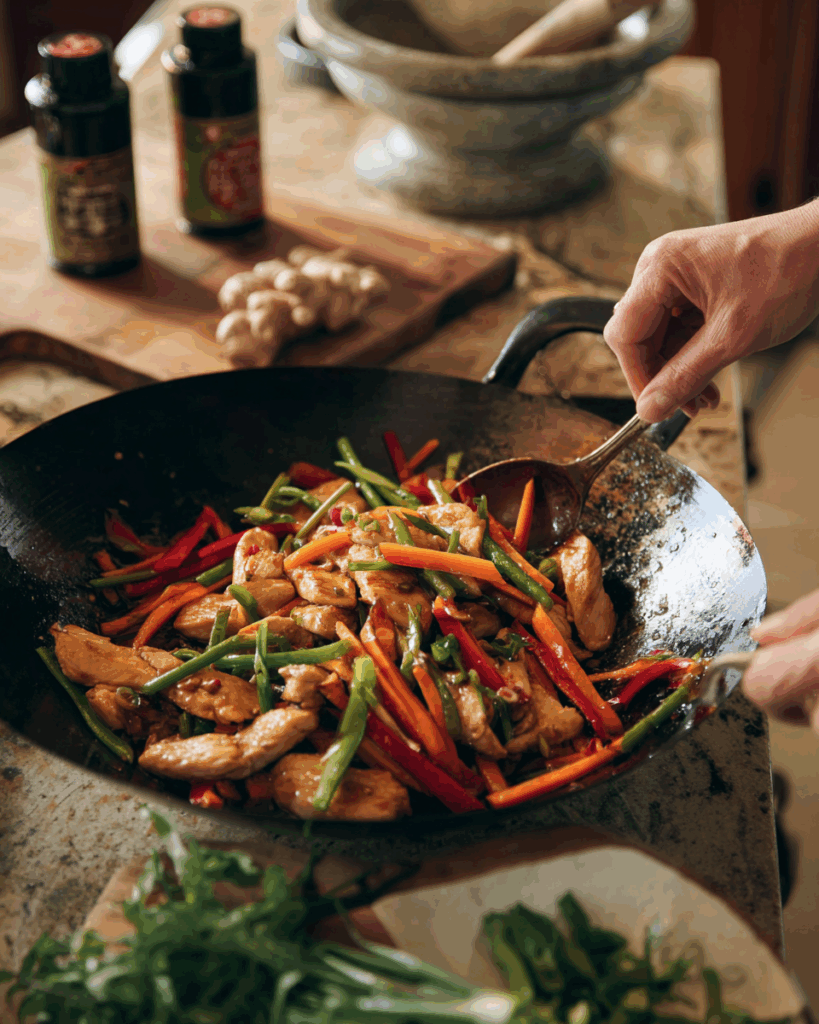
Nutritional Value of Key Ingredients
Thai Ginger Chicken isn’t just a flavorful delight; it’s also packed with nutrients that support a healthy lifestyle. Fresh ginger, the hero ingredient, is well-known for its medicinal properties. It contains powerful antioxidants and anti-inflammatory compounds that can help strengthen your immune system and improve digestion.
The chicken provides lean protein, which is essential for muscle repair and growth. Pairing it with a variety of vegetables like red bell peppers, mushrooms, and green onions adds vitamins A, C, and K, along with fiber and antioxidants to your plate. Jasmine rice, when eaten in moderation, serves as a great source of energy, rounding out this wholesome meal.
Is Thai Ginger Chicken Good for Weight Loss?
For those watching their calories, Thai Ginger Chicken can fit beautifully into a balanced diet. The dish is naturally low in saturated fat when prepared with lean chicken and minimal oil. Its high protein content keeps you full longer, while fresh vegetables contribute volume and nutrients without excessive calories.
To make it even more weight-loss friendly, you can reduce the amount of oil during cooking and serve it with brown rice or cauliflower rice instead of jasmine rice.
Next, let’s discover the delicious variations of Thai Ginger Chicken you can try to suit different tastes and dietary needs.
Variations of Thai Ginger Chicken
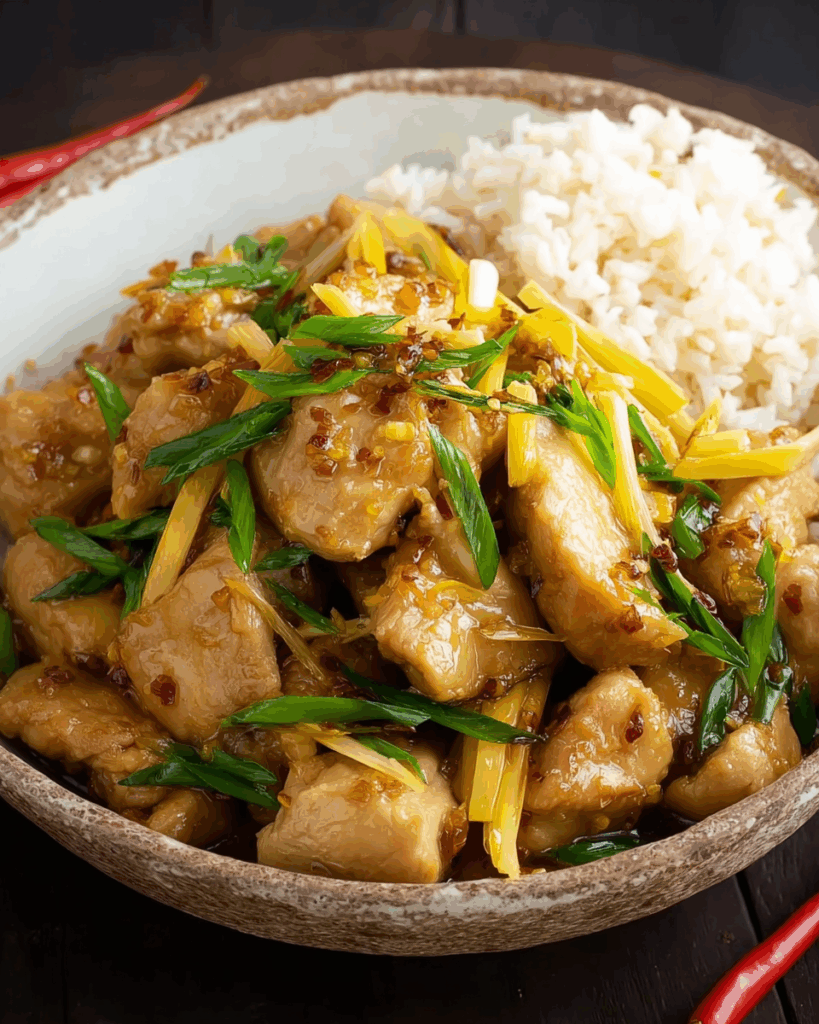
Thai Ginger Chicken and Rice
The most traditional way to enjoy Thai Ginger Chicken is paired with a warm bowl of jasmine rice. The tender chicken and crisp vegetables coated in a savory-sweet ginger sauce soak beautifully into the fluffy grains, creating a comforting, balanced meal. This version stays true to the classic Gai Pad King that’s a staple in Thai households and street food stalls alike.
Thai Ginger Chicken Stir-Fry with Noodles
For a fun twist, swap jasmine rice for rice noodles or egg noodles. This variation transforms the dish into a hearty noodle stir-fry where the flavorful sauce clings to every strand. Stir-frying the noodles together with the chicken and vegetables creates a satisfying one-pan meal perfect for busy weeknights.
Vegetarian and Vegan Options
Thai Ginger Chicken is incredibly versatile, making it easy to adapt for vegetarian or vegan diets. Replace chicken with firm tofu or tempeh, which both absorb the flavors of the sauce beautifully. Substitute fish sauce and oyster sauce with soy sauce or a vegan fish sauce alternative to maintain the umami depth without animal products. Adding extra mushrooms or baby corn enhances texture and keeps the dish hearty and satisfying.
Thai Ginger Chicken Chinese-Style
Another popular variation is inspired by Chinese stir-fry techniques. This style often includes cashews or water chestnuts for added crunch and uses slightly more soy sauce for a darker, richer flavor profile. It’s perfect for those who enjoy fusion-style Asian dishes and want a hint of Chinese influence in their Thai cooking.
These variations prove how flexible Thai Ginger Chicken can be, catering to a range of tastes, dietary needs, and preferences without losing its authentic roots.
Expert Cooking Tips for Restaurant-Quality Thai Ginger Chicken
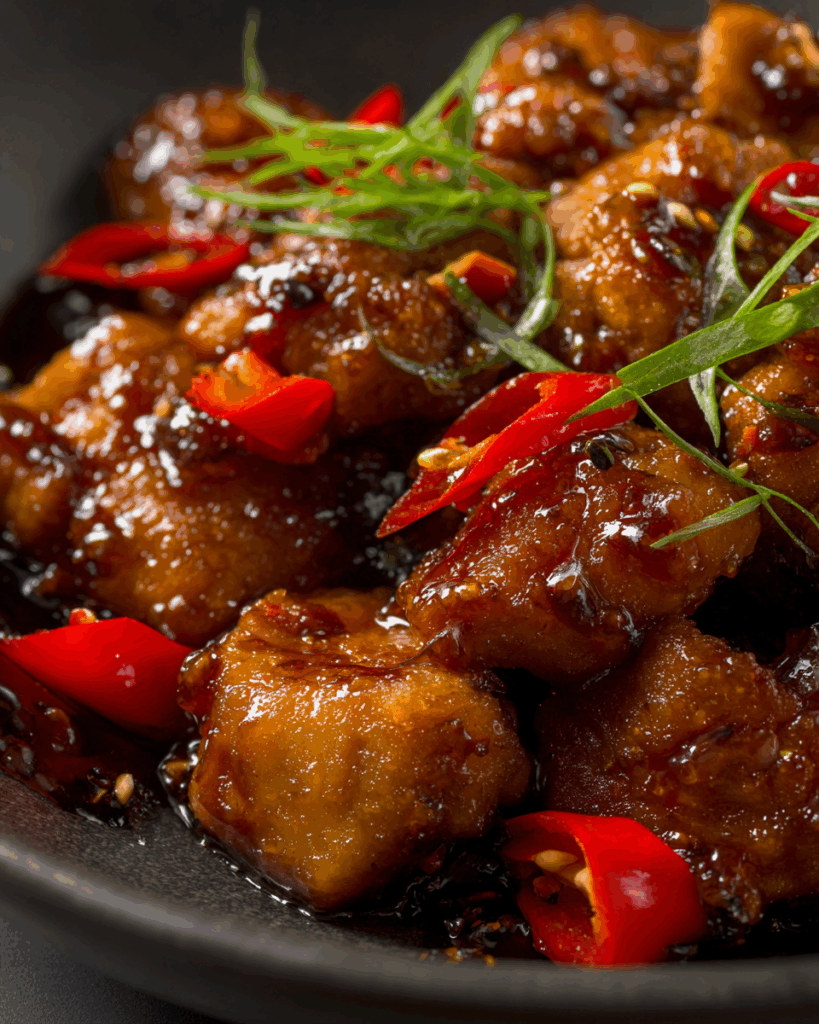
Using a Wok vs. Skillet
One of the secrets to creating authentic Thai Ginger Chicken lies in the cooking equipment. A traditional wok is ideal because it distributes heat evenly and allows ingredients to sear quickly without overcooking. If you don’t own a wok, a large, heavy-bottomed skillet can be a great alternative. Just make sure it’s wide enough to avoid overcrowding, which can cause ingredients to steam instead of stir-fry.
Balancing Flavors Like a Pro
Thai cooking is all about balance. Sweet, salty, sour, and spicy should work in harmony. Taste your sauce as you go and adjust the seasoning if needed. If it’s too salty, add a pinch of sugar or a splash of chicken broth to mellow it out. If it lacks depth, a few extra drops of fish sauce or oyster sauce can bring the umami back. For those who love heat, adding a bit more Thai red chili paste or fresh Thai chilies at the end gives the dish a spicy kick without overpowering the ginger’s delicate zing.
Keeping Vegetables Crisp and Vibrant
Cook vegetables quickly over high heat to retain their bright colors and crunchy textures. Overcooking leads to limp, dull veggies and a less appealing stir-fry. To avoid this, add firmer vegetables like bell peppers and carrots first, and softer ones like mushrooms and green onions toward the end.
Preparing Ingredients Ahead of Time
Thai Ginger Chicken comes together in minutes once the heat is on, so prepping everything in advance is crucial. Slice, chop, and measure all ingredients before cooking. This “mise en place” approach ensures a smooth and stress-free stir-frying process.
Pairing Thai Ginger Chicken with Other Thai Dishes
Best Side Dishes to Complement Thai Ginger Chicken
A meal with Thai Ginger Chicken can be elevated with carefully chosen sides that enhance the overall dining experience. One perfect pairing is Thai Basil Fried Rice, which brings a fragrant, slightly spicy profile to balance the ginger’s zing. Another favorite is a light Thai Papaya Salad, offering freshness and a hint of tangy sweetness that cuts through the savory stir-fry.
For a richer meal, add Thai Coconut Soup with Galangal. The creamy, aromatic broth pairs beautifully with the bold flavors of the stir-fry and provides a comforting contrast to the crisp vegetables and tender chicken.
Recommended Drinks for a Complete Experience
To round out the meal, serve Thai Iced Tea or Coconut Shake. The creamy sweetness of these drinks cools the palate and complements the savory and spicy notes of Thai Ginger Chicken. For a healthier option, fresh coconut water provides a refreshing, lightly sweet sip that ties together the meal’s flavors.
Pairing Thai Ginger Chicken with other Thai staples creates a balanced, vibrant meal that mirrors the variety and richness of a traditional Thai dining table.
Conclusion
Thai Ginger Chicken is more than just a quick stir-fry; it’s a vibrant representation of Thai culinary artistry where fresh ingredients and balanced flavors come together in perfect harmony. From its rich history rooted in Thai street food culture to its adaptability in modern kitchens, this dish has proven to be a timeless favorite for both beginners and seasoned cooks.
We’ve explored how to prepare authentic Thai Ginger Chicken step by step, shared expert tips for achieving restaurant-quality results, and even introduced delicious variations to suit every taste and dietary need. With its tender slices of chicken, crisp vegetables, and the invigorating aroma of fresh ginger, it’s no wonder this stir-fry continues to capture hearts and taste buds worldwide.
The next time you’re craving a flavorful, satisfying meal, remember that Thai Ginger Chicken is not only easy to prepare but also a healthy choice packed with nutrients. Try serving it with jasmine rice, noodles, or even cauliflower rice for a lighter option.
If you loved exploring this recipe, don’t miss trying our Thai Chicken and Ginger Noodles for another twist on these classic flavors. And for a sweet finish to your meal, consider pairing it with a Thai Coconut Shake for the ultimate Thai dining experience.
Bring the bold, beautiful flavors of Thailand into your kitchen and make every bite a celebration of taste and tradition.
Frequently Asked Questions
How do I store and reheat Thai Ginger Chicken leftovers?
To store, place cooled Thai Ginger Chicken in an airtight container and refrigerate for up to three days. For reheating, use a skillet over medium heat to warm it gently and preserve the texture of the vegetables and chicken. Avoid microwaving if possible, as it can make the chicken rubbery and the vegetables soggy.
Is Thai Ginger Chicken gluten-free?
Thai Ginger Chicken can be made gluten-free with a few adjustments. Use gluten-free soy sauce or tamari instead of regular soy sauce and ensure your oyster sauce and fish sauce are labeled gluten-free. Serve the stir-fry with plain jasmine rice or gluten-free noodles to complete the meal safely.
Can I make Thai Ginger Chicken spicy?
Yes, Thai Ginger Chicken can easily be customized to your heat preference. The traditional recipe uses Thai red chili paste for a subtle warmth, but you can increase the amount or add fresh Thai bird’s eye chilies for an extra fiery touch. For a milder version, reduce or omit the chili paste altogether and let the ginger’s natural spice shine.
What type of ginger should I use for Thai Ginger Chicken?
Always use fresh ginger for the most authentic flavor. Young ginger, if available, is ideal because it’s tender, less fibrous, and has a milder heat compared to mature ginger. Peel it carefully and cut it into thin matchsticks to release its aromatic oils into the stir-fry. Powdered ginger or ginger paste doesn’t deliver the same bright, zesty kick and should be avoided.

